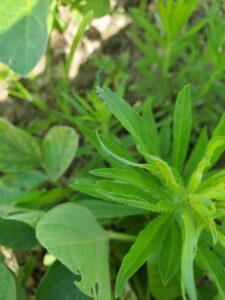Crop fields continue to be a smorgesborg for insect and insect vectored pathogens. With four different planting groups of soybean and three of corn, foliar and silk clipping pests are making their presence known in soybeans and corn.
Corn: Japanese beetle feeding continues to expand across soybean fields. The abundance of healthy stands and silk emergence in early planted corn will shift these leaf feeders over to corn silks. This planting group is overall in excellent condition and most fields have obtained maxiumum height and nitrogen utilization. These fields have very high stand populations and leaf development. Hopefully this will help mitigate the edge feeding losses from Japanese beetles and another silk clipper, stinkbugs. In the coming weeks after pollination, good air flow and lower humidity through grain fill is needed to limit mycotoxin development.
Late May and June planted corn up to three feet in height oversaturated just prior to planting continues to show signs of moisture stress, and soil compaction issues. These fields are in the rapid stem elongation phase and were leaf curling this week in the high heat. Several fields are symptomatic for nitrogen deficiency as a result of those earlier ponding events. Soils are sunbaked on the surface and fields with higher clay content are root zone compacted. These are the fields to monitor for economic damage from silk clipping if the crop continues to be under heat stress. To limit further yield losses, these acres are more likely to benefit from insecticide treatments during silking still a few weeks away. Stink bugs in V1 to V6 plantings are most likely to be of economic concern and treatable in this corn group when 1 out of ten plants have bugs; decreasing to 1 out of every four at reproductive stage.
July planted corn is less effected by moisture and heat stress. The root systems of these v1 to v5 plantings have found adequate surface soil moisture from last week’s rains and are loving this heat and humidity. This crop group is highly variable for soil compaction depending on the quality of the soil and the path of heavy rainfall just prior to planting.
Soybeans: Overwintering pests of concern vectoring diseases to soybeans have emerged in abudance from vegetation in field edges, old meadows, and grass hay fields. The acreage and variability in cover crop plantings and cash grain crop plantings last fall was ideal for insect populations and residue infected bacterial innoculums to increase.
Along the south-west side of the county, in uncanopied vegetative beans on sandy soils, wind-rain-sand deposition of soil onto leaves occurred in recent storms and disease progression is evident on stems and leaves. Field comparisions here observed tillage at planting reduced movement of bacterial innoculum onto stems and leaves in canopied stands in contrast to adjacent no-tilled early vegetative stands. On the opposite corner of the county, oversaturated, low-lying loamy fields recently fitted for planting are showing expected variablity in stand establishment.

Soybean stem borer adults are present in bean after bean fields
On better ground without compaction issues, most early planted fields are in good foliage condition. Early R stage beans that were under heat and moisture stress last week show signs of self-abortion of lower stem flowers. Management of insect feeding and variatal resistance response in these fields is optimum. Crop rotation matched to soil type and timing of inputs stands out as the key niche for uniform early planted stand evaluations. In these ideal stands, evaluate what combination of variety, tillage, prior crop rotation, planting date, and timing of inputs and preciptation thwarted insect vectored diseases.
Observations on later planted beans are quite variable regardless of when inputs were applied. Grasshoppers, japanese beetles, spider mites and thrips have already vectored leaf diseases in this group. Soybean stem borer adults and larva were observed in v4 to v5 fields.
Knowing the weather was just not ideal for this planting group, document signs and progression of insect vectored diseases in the foliage, exterior of stems, interior of stems, cross section of roots, feeder root presence and presence of healthy nitrogen fixing bacteria by variety.
Healthy stems and roots in the vegetative stage are a good sign plants will respond to foliar feeds if needed. Expect insect pressure to continue to build. Soybean diseases overlap as do insect stages and feeding pressure. While one pathogen may be of minimal concern in early planted beans, another may take over second plantings and dominate later plantings as season progresses.

